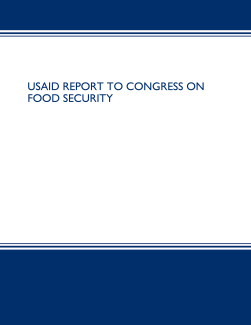Sustainability of development gains is a key facet of USAID’s work. In all areas, USAID aims to implement programs that support communities to move beyond the need for U.S. assistance, and position them as stronger allies and trading partners. USAID investments under Feed the Future, the U.S. government’s flagship global hunger initiative, are made with the same objectives in mind. Born from the 2007-2008 global food price crisis, the U.S. government launched Feed the Future to support longer-term investment in agriculture to improve countries’ food security –helping to prevent future food emergencies, rather than just respond to them.
Our investments in Feed the Future have created a sustained impact. During the first decade of Feed the Future, in areas where we focused our efforts, the prevalence of extreme poverty decreased by an average of 19 percent, and the proportion of households experiencing hunger decreased by an average of 30 percent. In addition, the prevalence of stunting among children under five declined by an average of 26 percent—representing a total of 1.8 million children with reduced risk of stunting. Over the life of the initiative, Feed the Future participants have accessed $5 billion in agriculture-related financing and generated over $28 billion in sales of agricultural products and services.
However, there is more that can be done, especially as the world navigates significant challenges that impact the resilience and stability of the global food system. Even before Russia’s invasion of Ukraine, the world’s food system was reeling from protracted conflicts, the enduring impacts of the Covid-19 pandemic, and increasingly frequent and severe weather and climate shocks. Russia’s invasion of Ukraine up-ended global fuel, food, and fertilizer supplies, causing prices to spike and revealing critical weaknesses in the global food system—namely the vulnerability of certain net food importer nations, especially highly food insecure countries in Africa, to changes in global markets. Over the past year, global prices have declined and levels of poverty and food insecurity have either declined or stabilized, but global needs are still higher today than before the onset of the food security crisis. Over 735 million people around the world suffer from chronic hunger, including over 260 million people in sub-Saharan Africa.
Recovering progress lost due to these unprecedented shocks requires strategic, concentrated investments that help public funds go further and have a lasting impact. Fundamentally, we know the best way to fight hunger and poverty is to invest in agricultural growth, since it is up to four times more effective at eliminating extreme poverty in low and middle income countries than growth in other sectors. Over the past decade, Feed the Future has done just that—investing in agriculture-led growth, building resilient food systems, and enhancing access to nutritious diets in a set of target countries with high levels of need. However, over time those areas of focus multiplied along with global need, and now Feed the Future divides its budget among a total of 40 countries around the world.
In accordance with Congress’ intent in FY24 appropriations, USAID is working toward increasing the impact and longevity of our food security investments through Feed the Future. We prioritize investments in countries that show both high potential for driving inclusive economic and agricultural growth, and the commitment to invest in their own food systems.

